If you want to catch a tram in Melbourne then you need a Myki, despite the fact you can’t buy one or top it up onboard the tram. In 2017 The Age highlighted the difficulty this can pose for intending tram passengers, in an article on myki “dead zones” – tram stops where the nearest place to top up your myki is at least a kilometre away. Coincidently I started work on an almost identical project years ago but never finished it, so what better time to polish it off?
Some background
An integral part of the original Myki system was ticket machines onboard trams – they would have allowed passengers to top up their myki, or to purchase a ‘Short Term Ticket’ if they didn’t hold a myki.
A single ticket machine was installed onboard a Melbourne tram in early 2009 as part of the myki field trial program, with it remaining in place but not in use until at least November 2011.
Short Term Tickets were a cardboard smartcard which entitled the holder to 2 hour of travel, for a cost slightly more than the normal fare charged to standard myki users.
Sales of these tickets commenced in 2009 when Myki went live in Geelong, and they continue to be sold onboard buses in Geelong, Ballarat, Bendigo, Seymour and the Latrobe Valley until 2013.
In Melbourne the sale of Short Term Tickets was never enabled, with the option to do so being disabled for all myki machines located in the city.
The rollout of short term fares and myki machines onboard trams was cancelled by the Baillieu Government in June 2011, acting on advice contained in a secret report by consulting firm Deloitte.
One reason given for the reason for the withdrawal of Short Term Ticket was due to the cards costing $0.40 cents each to manufacture – making up almost half of the $0.90 charged for a concession bus fare in Geelong!
In 2011 Yarra Trams said that the change would reduce the tram company’s costs, boost space for passengers and reduce fare evasion issues by eliminating a key reason given for not buying a ticket.
Everyone else says the cancellation of Short Term Tickets and onboard top ups make it much more difficult for passengers who only use trams to pay their fare.
Enter the Public Transport Victoria API
Back in March 2014 Public Transport Victoria finally opened up the application program interface (API) which powers their mobile apps, so I decided to have a play around with it.
With the mobile landscape already littered with hundreds of different trip planning apps, I decided to build something slightly different – something to point out how the lack of ticket purchase options onboard trams was wasting the time of the intending passengers.
The API allows programmers to access all kinds of data – tram routes and Myki retailers being two of them, so I built an app that caters for two use cases:
- you’re at home, work, or a friend’s house – and you’ve discovered that you don’t have a Myki on hand. Where is the nearest place to buy a new one, and how far will this detour take compared to purchasing a ticket onboard the tram?
- you’ve just stepped onto a tram and discovered that you don’t have any credit left on your Myki. How far will you have to walk to top up, and then where can you get back on your way?
The end result is ‘walki‘ – a small app that works on any device with a web browser.
The logic in the app is as follows:
- Show the user their current location,
- Calculate distance to nearest tram stop,
- Calculate distance to nearest Myki retailer,
- Calculate distance from Myki retailer back to nearest tram stop,
- Plot the walking routes on a map,
- Compare the distances for each,
- And finally, show the user much further they have to walk thanks to the lack of ticket sales onboard trams.
Simple?
You can see it for yourself at https://wongm.com/walki/, or using these examples.
Technology
The app itself isn’t anything revolutionary from a technology standpoint.
In the backend I’m using boring old PHP to gather tram stop and myki retailer locations through calls to the PTV API, with the resulting data being mashed around in Javascript until they are drawn out on a pretty map.
The frontend code is static HTML files with a smattering of jQuery Mobile (‘state of the art’ for 2014? :-P) over the top, with the maps being drawn using the Google Maps JavaScript API v3.
The files are all hosted on my vanilla Apache web server, and you can find the source code on GitHub.
Footnote
Here is the original article from The Age – Melbourne’s myki retailers: Where is the nearest place to top up my myki?, by Craig Butt and Andy Ball.
They are the myki dead zones – the tram stops where the nearest place to top up your myki is at least a kilometre away.
If you do not have any credit on your myki you are expected to take reasonable steps to top up, but from these locations you rack up at least 1200 paces to get to the nearest store or machine.
Using the interactive below, you can detect myki dead zones on your tram line and find out where the nearest myki retailer is, in case you ever find yourself short on credit.
One consideration I completely forgot about was the opening hours of Myki retailers:
But keep in mind the opening times of the retailer. When we trekked 1.5 kilometres through Melbourne’s biggest myki desert on a scorching 31 degree day to top up at Bundoora Post Office, we were fortunate enough to get there half an hour before closing time.
But we would have been out of luck after 5pm that afternoon, after midday on Saturday, or when it is closed all day on Sunday.
About 95 per cent of the state’s 800-plus myki retail outlets are open on Saturday, 75 per cent on Sunday and 32.5 per cent are open all hours.
But one thing we did agree on is the lack of Myki retailers along route 86.
And if you live near Plenty Road in Bundoora and rely on the route 86 tram, you’re in the worst spot in Melbourne.
The stop at the corner of Plenty Road and Greenwood Drive is the worst myki dead zone in Victoria for trams. If you forget your card or are out of credit, it’s a 1.5 kilometre walk to the nearest post office to top up.
I included a few examples in my app, one from Reservoir resulting in an extra 1.86 kilometre (23 minute) long walk!
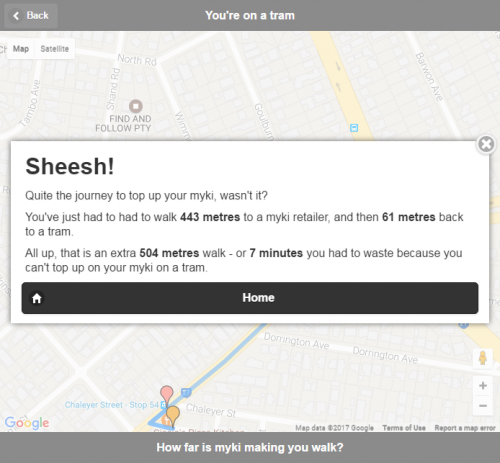
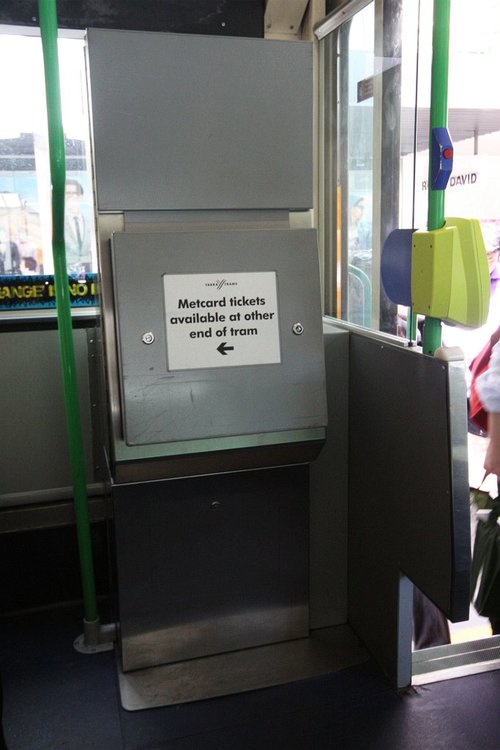
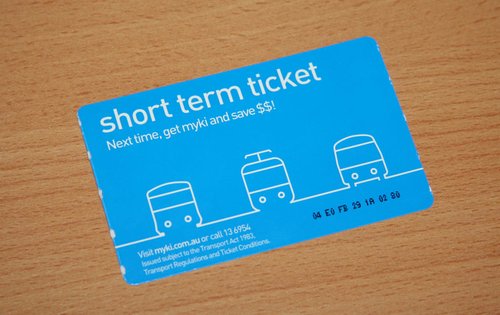
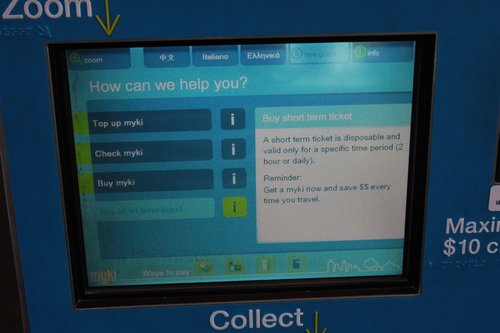
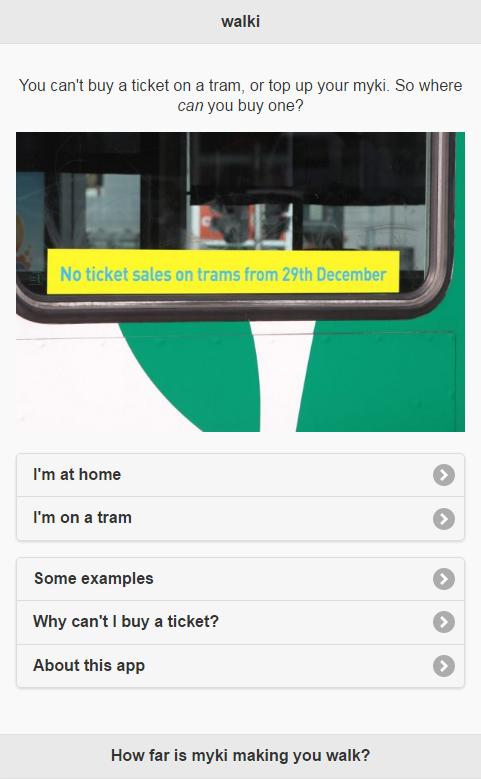
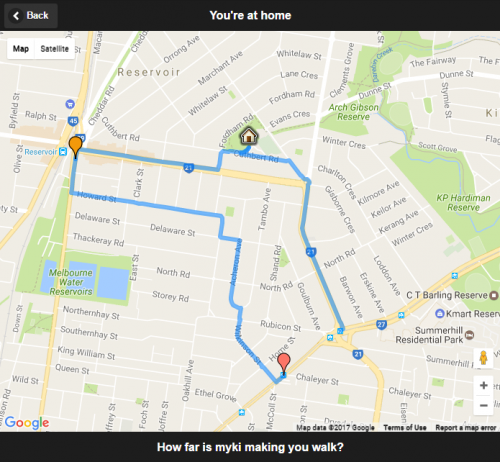

Is there a reason why you can’t link your myki to your
credit card? Here in the SF Bay Area all Transit is tied to
your Clipper card. I set mine to add $45 to my Clipper
when it goes below $10. The next time I tag on a tram,
bus, train or ferry with less then $10 I am automatically
credited $45. The Clipper card also knows when you
change trams or buses and accepts the 90 minutes
free transfer by not changing your card when you tag
onto your second tram.
There is the option to link a Myki to a credit card or to manually topup online:
https://www.ptv.vic.gov.au/autotopup/
The gotcha is that you need an Australian issued credit cards, and that ah-hoc topups aren’t instant.
http://www.danielbowen.com/2012/11/26/myki-topup-instant/
Hence you you go to catch a tram and discover your balance to too low, you have to walk to a place where you can top up.
Either use auto-top up or plan ahead! There’s really no excuse for not using auto-top up. Don’t have an Australian credit card? Get a reloadable debit card at Australia Post, Woolworths etc and set it up through that.
In Sydney you can’t top up or buy an Opal card on a bus, though you can pay a cash fare on most “all stops” bus routes as long as you don’t board the bus in the Sydney or Parramatta CBDs. You can top up your Opal card at some tram stops but can’t buy one. You can top up an Opal Card at about less than 50% of stations, and buy a single use card at even fewer. You can’t buy or top up an Opal card on a ferry – though you can top up and buy a single use card at some wharves. Some of our train stations without top-up or single use Opal card facilities are many km away from an Opal Card retailer. And we survive!
It was confusing for me as an outsider:
https://wongm.com/2016/07/why-is-buying-sydney-opal-card-so-difficult/
There is also the reason of money.
Not everyone can afford Auto Top-Up. If you earn enough, it is convenient (if still a little delayed). If you do not earn enough, you’ll be struggling to afford it.
This might sound a bit cynical but part of me also thinks that increased fine revenue may have played a part as well in abolishing short-term tickets.
I also dislike the arbitrary (and wasteful) 4-year expiry date for Myki cards but that is another discussion altogether…
From the limited data I could find bus passengers often top up with loose change, and only when they hit a negative balance.
https://wongm.com/2017/04/bus-passenger-myki-topup-amounts/
Excuse me, but there is a very powerful ‘excuse’ not to use auto top-up: it requires placing trust in the operators of the Myki system and, importantly, in their badly designed software. One mistake in a transaction could wipe out the entire credit limit of a credit card and it would take weeks to get the money back, no doubt after filling in paper forms and mailing them to PTV. If Myki’s website can’t meet current standards for usability and the speed of transactions, we have no reason to expect that its automatic top-up system would function properly.
It should not be up to the people to modify their behaviour to suit a poorly designed user interface.
Not to mention low income users might have not funds in their account in order for the auto top-up to occur.
https://www.humanservices.gov.au/customer/enablers/my-bank-account-overdrawn
[…] few weeks ago I asked the question – How far is Myki making you walk? Turns out many think that selling a tickets onboard public transport is a needless luxury, and that […]
Myki is still a problem with the dead zones, especially at night. Vermont South is a horrible dead zone, usually the only way to top up there is hope that buses are still running and the driver has the machine turned on, as the only place around Vermont South is a 9 to 5 chemist inside the shopping centre, meanwhile a 24-hour Shell/Coles Express service station is right out the front next to the tram stop! While 7-Elevens have myki equipment, they aren’t exactly on every street corner once you leave the CBD. Of course it was beyond the government to even think of putting myki top-up equipment in places which are open late (aside from 7-Eleven), such as supermarkets or petrol stations.
Reminds me of this story a year ago – a local trader complaining PTV refuses to consider new applications from prospective vendors, despite being next door to a tram stop and railway station:
http://www.heraldsun.com.au/leader/inner-east/store-owner-david-huynh-says-authorities-wont-let-him-sell-myki-topups-despite-huge-demand/news-story/a20c2b32bff8e61a3780c1b2a8ac758b
This is not just an issue with trams. Some years ago I had to change busses at Southland. There was no Myki machine to top up my card at the bus interchange and the only shop in the complex which did it was a newsagent on the top level.
Odd that bus interchange doesn’t have a Myki machines – Highpoint has one.
As does Chadstone.
[…] And stores were finally selling a $14 ‘Myki Visitors Pack‘ that was supposed to make up for the lack of ticket machines onboard trams. […]
[…] bus passengers in Melbourne there’s no way to purchase a ticket onboard the vehicle – random retail outlets are the only place where you can purchase a Myki so that you can travel. So how much does Public […]